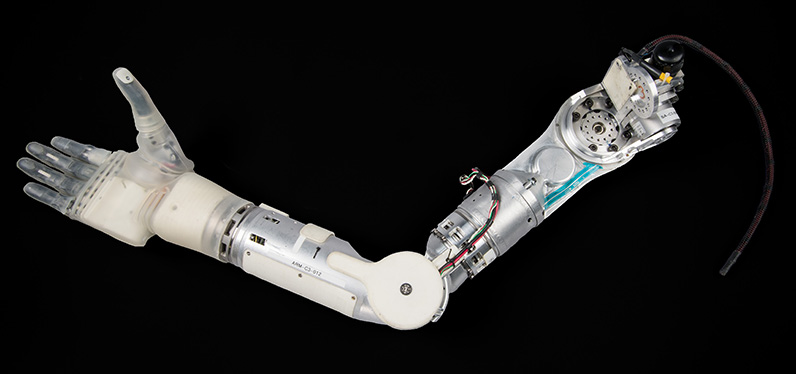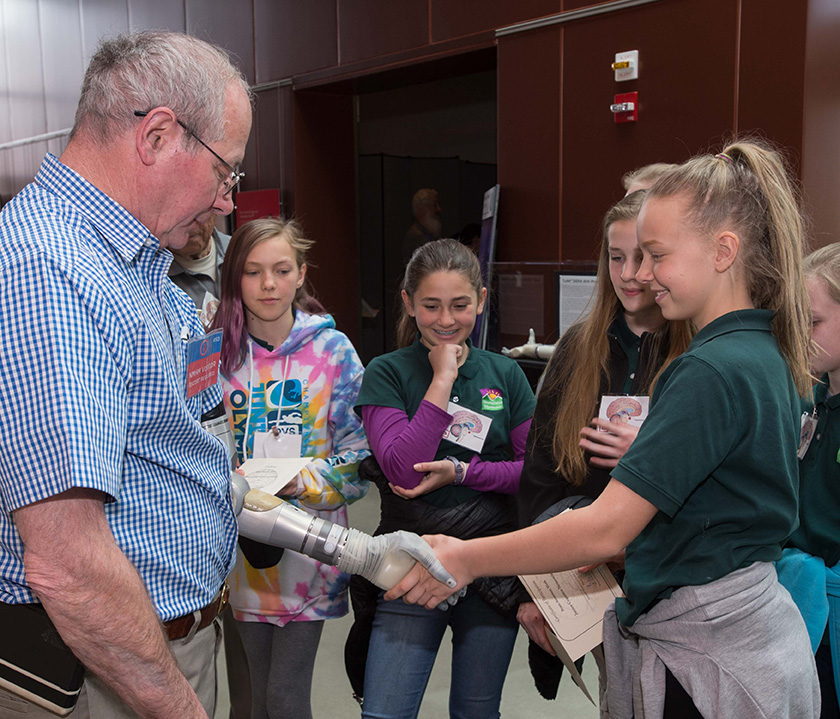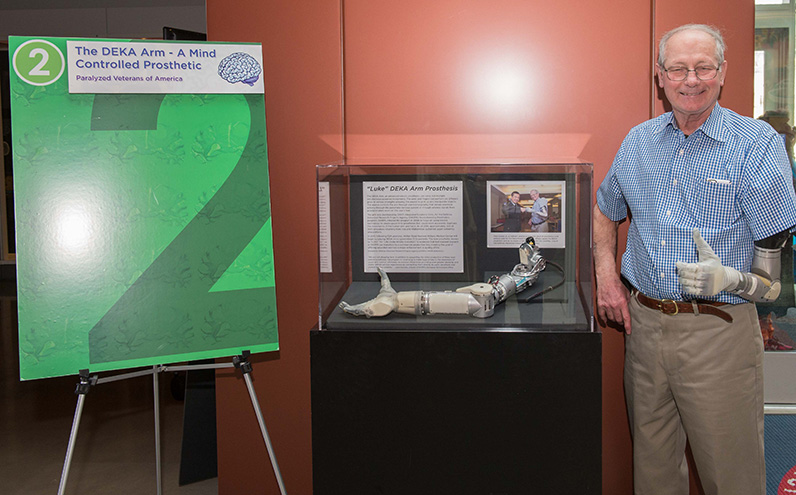Advanced Bionic Prosthetic Arm Added to Medical Museum Collection
By Lauren Bigge
NMHM Public Affairs Coordinator
A radically advanced bionic arm, developed by DEKA Research & Development with funding from the Defense Advanced Research Projects Agency (DARPA), was recently provided to the National Museum of Health and Medicine (NMHM). The innovative prosthetic device now on display at NMHM is known as the Gen 2 DEKA Arm, an early prototype of the now commercially-available Gen 3 Arm, which is marketed by Mobius Bionics LLC as the "LUKE Arm" (Life Under Kinetic Evolution). The LUKE Arm is the first integrated upper-extremity prosthesis cleared by the U.S. Food and Drug Administration. NMHM is a Department of Defense museum and an element of the Defense Health Agency, Research and Development Directorate (J-9).
Like the prototype on display, the LUKE Arm can be controlled in a variety of ways, depending on the user's preference and ability. Control techniques include surface electromyographic electrodes (EMG) and foot-mounted inertial measurement units (IMU). EMG electrodes touch the user's skin and sense electrical activity from muscles in the residual limb that would have moved the natural limb in a desired way. In the case of the IMUs, as the user tilts his or her feet from toe-to-heel or side-to-side, accelerometers in the IMU on the foot send wireless signals to guide the prosthetic arm and hand. Signals from both EMG and IMU are received by a computer embedded in the prosthesis, which then instructs the motors in the arm to produce simultaneous, complex, multi-directional movements.
The museum's artifact on display is a full arm system, or shoulder configuration. To accommodate different amputation levels, the shoulder configuration, of both the DEKA and LUKE Arm, is modular, with humeral and radial configurations to fit on a user's mid-upper arm or mid-lower arm respectively.
The museum acquired the Gen 2 DEKA Arm in late December 2015, thanks in part to the long-term advocacy of Dr. Geoffrey Ling, former director of DARPA's Biological Technologies Office. Ling, a retired military physician who served in Iraq and Afghanistan, wanted to provide upper limb amputees with a prosthetic arm performance capability that far exceeded the options available at the time, and was also intuitive to use and comfortable to wear. He announced the DARPA "Revolutionizing Prosthetics" program in 2005 to achieve that ambitious goal.
Inventor Dean Kamen and his team at DEKA Research & Development Corp. in Manchester, N.H., developed the DEKA Arm as part of the Revolutionizing Prosthetics program. Over the years, the Revolutionizing Prosthetics program more than delivered on DARPA's goal; the final LUKE Arm system provides up to 10 powered degrees of movement and gives the user feedback on grip strength. The full system includes a powered shoulder that allows the arm to reach over the user's head or behind the back; a powered elbow strong enough to lift a bag of groceries from floor to tabletop; and a powered wrist with the dexterity and range of motion to hold a glass of water overhead or at waist level without spilling.
Alan Hawk, who manages the Historical Collections at NMHM, reached out to DARPA in 2005, checking about the prostheses in development, and encouraged Dr. Ling to consider whether a DEKA Arm would be a valuable addition to the museum's artifact collection.
"Dr. Ling understood how a museum collection can help inform future developments of a particular piece of medical technology, and was very enthusiastic about the prospect of coordinating the transfer of a DEKA Arm to NMHM," said Hawk.
The Gen 2 DEKA Arm is now part of a collection that includes 10 upper limb prostheses and seven upper limb terminal devices (such as a hand or a hook) dating from the mid-19th century to the late 20th century. "This artifact represents the latest example of the military's commitment, beginning during the Civil War, to the rehabilitation of service members sustaining amputation of the upper limb," said Hawk.
The museum prospectively collects contemporary advances in military medical technologies, such as prosthetics, so that historic antecedents can be compared and contrasted to modern developments, and that the collection remains current, especially as radical innovations such as the LUKE Arm reach the market. The collection includes examples of artificial arms issued to soldiers during the Civil War and World War II, as well as artificial hands developed by the Army Prosthetics Research Laboratory after World War II.
NMHM first displayed the Gen 2 DEKA Arm during Brain Awareness Week (BAW) in March 2016. Brain Awareness Week at NMHM is an annual program that engages middle-school students with working brain scientists and researchers as part of an effort to increase awareness and interest in the brain sciences, and especially relevant military medical research in that field.
During the March 2017 Brain Awareness Week, the Gen 2 DEKA Arm was on display. NMHM partnered with Fred Downs, who currently wears the Gen 3 version of the prosthesis, to demonstrate the technologies to BAW participants.
Downs is the retired national director of the U.S. Department of Veterans Affairs (VA) Prosthetic and Sensory Aids Service. He was severely wounded when, as an Army platoon leader during the Vietnam War, he triggered an antipersonnel mine, resulting in a transhumeral amputation of his left arm. For 48 years he used a body-powered prosthetic left arm, with a hook for the hand. Then Downs participated in several studies using the DEKA Arm starting in 2008, prior to FDA clearance. Since April 2015, Downs has been regularly wearing the Gen 3 DEKA Arm as part of a home trial.
Downs said he much prefers the Gen 3 DEKA Arm to the Gen 2 DEKA Arm. "This is really streamlined compared to the earlier versions," he said. "My arm has more functional movements." The system's hand can perform six different, pre-programmed grips, exerting various strengths to pick up and manipulate objects. He told the students that the "power" grip, for example, allows him to carry a heavy bag of groceries or hold a full wine bottle. The "lateral pinch" works for holding an item like a key, while "fine pinch open" and "fine pinch closed" may be used for very small items.
He appreciates key differences in this upgrade: having new freedom in the wrist function (known as ulnar/radial deviation); tiny lights – blue or white – that indicate the arm or hand are activated; more hours of life for both the batteries in his IMUs and the one for the arm; and a signal to indicate if there is a fault with the device. The LUKE Arm has new compact, more responsive foot controls and is resistant to water and dust.
During his BAW presentation, Downs shook hands with students using the hand's "power" grip. They were amazed to watch his prosthesis move as his left and right feet rocked from heel to toe and then back, or rolled sideways. He explained that the left foot controls the arm, the wrist action and changes the grip, while the right foot's IMU signal tells the hand to open and close, or the entire hand and wrist to move outward if the foot rolls right. "I have to pay attention to everything I am doing," he told them.
When controlled by the IMUs, the DEKA Arm cannot change positions or grips while in motion – whether the amputee is walking, driving an automobile or riding on an airplane or train, Downs noted. "Once I start moving my feet, the arm goes into Standby. It won't move," Downs said. The arm goes into a walk mode, which can maintain a closed grip so users don't drop items they are carrying.
Walter Reed National Military Medical Center has begun preparations to conduct trials with the LUKE Arm this year as part of a prosthetics fitting workshop. Mobius Bionics, LLC, the manufacturing company established to market the DEKA technology, will train the Walter Reed staff to fit the prostheses. The ultimate goal is to identify who is best suited to use the LUKE Arm and for those users to determine how the LUKE Arm can best enable their daily routines.
"What I'm doing now proves that this thing has increased functionality. It needs to continue to advance, and the control system is a part of that. It's important to keep that momentum going," Downs said.
The momentum is continuing, confirmed Tom Doyon, project manager and lead electrical engineer at DEKA Research & Development. DEKA is continuing to improve the technology as part of DARPA's Hand Proprioception and Touch Interfaces (HAPTIX) program. "Our part in the program is to add many more sensors to the hand that can sense touch and objects in the hand, for example," he said. Doyon noted that other DARPA HAPTIX researchers are developing neural interfaces that will allow an amputee's intact nerves to control the prosthesis and even provide sensory feedback to the user through his or her nerves. The amputee will be able to "feel" thanks to the information provided by the new sensors in the DEKA Arm. After testing and FDA clearance, these sensors may be able to migrate into the LUKE Arm.
The technological advancement of the LUKE Arm offers hope to Downs as well as other wounded service members and veterans; according to the U.S. Department of Veterans Affairs, approximately 320 of the 1,600 amputees who returned from Iraq and Afghanistan as of 2014 had upper limb amputations. In fiscal 2016, the VA provided care to 20,158 veterans with upper-limb amputations, comprising 22% of all amputee veterans receiving VA care in fiscal 2016. Of those, 3,225 had a major upper-limb amputation (wrist level or higher on the arm).
Click any photo to view larger version






